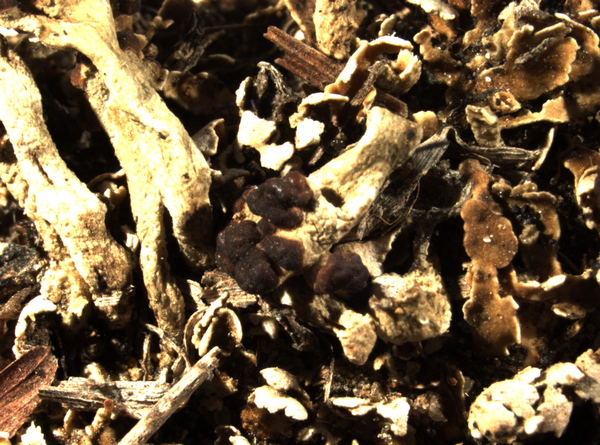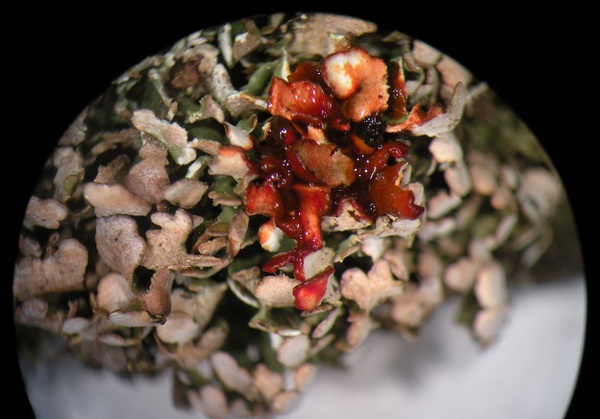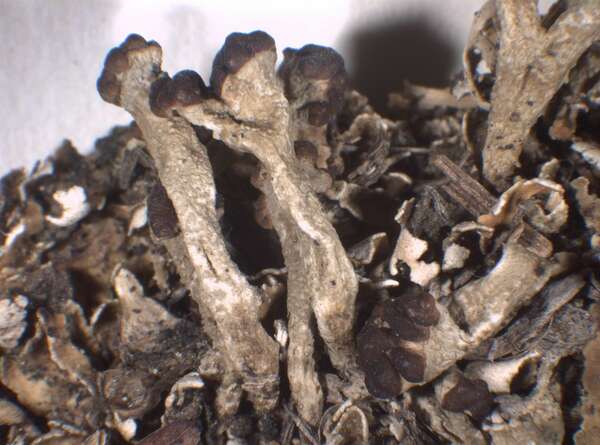Cladonia polycarpoides Nyl.
in Zwackh, Lich. Exs.: 626, 626 bis (correction label), 1892.
Synonyms: Cladonia subcariosa auct. non Nyl.
Distribution: N - Frl (Tretiach & Hafellner 2000), TAA, Lomb (Rossi 1991, Rivellini & Valcuvia 1996, Gheza 2018, Lich. Ital. Exs. 50: Isocrono & al. 2021, Gheza & al. 2022), VA (Piervittori & Isocrono 1999), Piem (Ravera & al. 2017, Gheza 2018, 2020), Lig (Gheza & al. 2020). C - Abr (Nimis & Tretiach 1999, Gheza & al. 2021), Sar (Nöske 2000, Nöske & al. 2000).
Description: Primary thallus squamulose, persistent, the squamules large and prominent, ascending, forming dense mats, 3-10(-15) mm long, 2-5(-7) mm wide, olive-green above, white, but often becoming bluish, reddish brown or rarely brownish grey beneath. Podetia rather rare, cupless and thicker at apex, simple or rarely sparsely branched, often solid inside, olive-green to brown, 0.5-2 cm tall, c. 1.5 mm thick, almost continuously verruculose-corticate, esorediate, rarely squamulose at base. Apothecia common, dark brown, convex, forming larger subcorymbose aggregates which are 5-8 mm wide. Asci 8-spored, clavate, thickened at apex, with a K/I+ blue tholus and a K/I+ strongly blue outer gelatinous sheath, Cladonia-type. Ascospores 1-celled, hyaline, ellipsoid. Pycnidia dark, semi-immersed on basal squamules, with a colourless jelly. Conidia hyaline, curved. Photobiont chlorococcoid. Spot tests: K+ yellow rapidly turning red, C-, KC-, P+ yellow to red (slow reaction). UV-. Chemistry: norstictic acid, with traces of connorstictic acid, exceptionally homoheveadric acid, stictic or fumarprotocetraric acid complex, very rarely with atranorin.Note: a mainly temperate lichen found on sandy mineral soil in open grasslands and on soil pockets on large isolated boulders, probably somehow overlooked in Italy and more widespread in the Alps.
Growth form: Fruticose
Substrata: soil, terricolous mosses, and plant debris
Photobiont: green algae other than Trentepohlia
Reproductive strategy: mainly sexual
Commonnes-rarity: (info)
Alpine belt: absent
Subalpine belt: extremely rare
Oromediterranean belt: absent
Montane belt: rather rare
Submediterranean belt: very rare
Padanian area: extremely rare
Humid submediterranean belt: absent
Humid mediterranean belt: absent
Dry mediterranean belt: absent
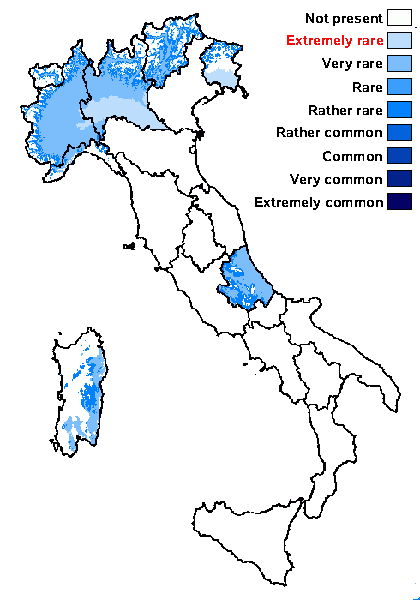
Predictive model
Herbarium samples
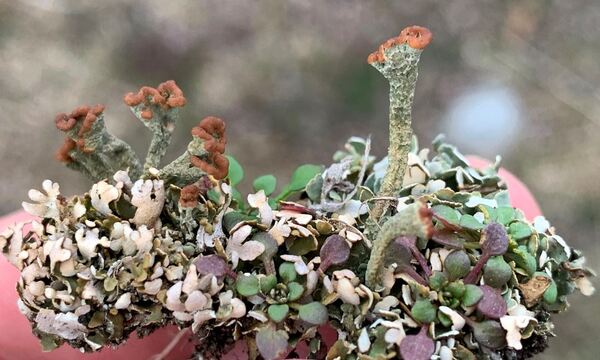
Gabriele Gheza - https://lichenidilombardia.home.blog
Italy, Lombardia, Varese, Vizzola Ticino, valle del Ticino, 162 m
17/03/2021
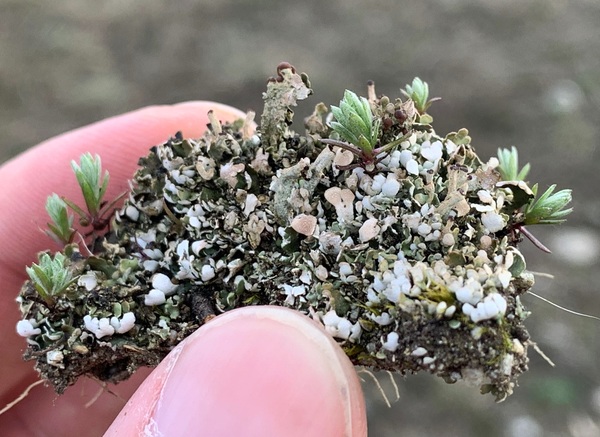
Gabriele Gheza - https://lichenidilombardia.home.blog
Italy, Lombardia, Varese, Vizzola Ticino, valle del Ticino, 162 m
17/03/2021
fertile specimens
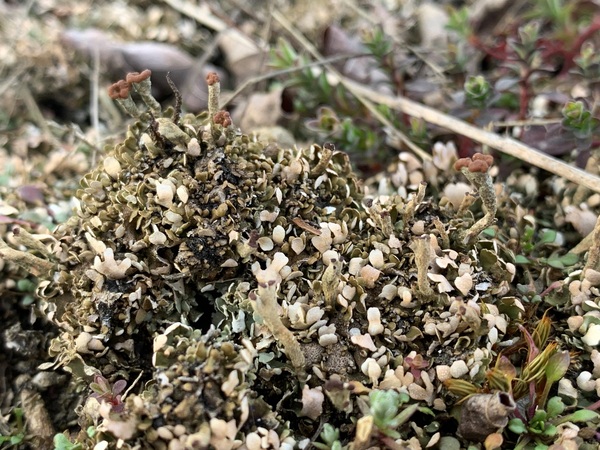
Gabriele Gheza - https://lichenidilombardia.home.blog
Italy, Lombardia, Varese, Vizzola Ticino, valle del Ticino, 162 m
17/03/2021
fertile specimens
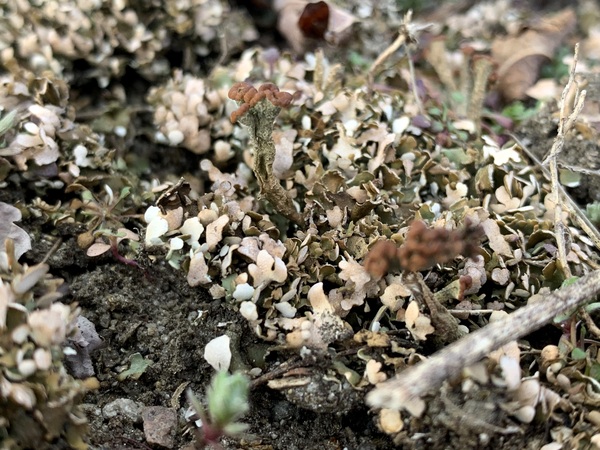
Gabriele Gheza - https://lichenidilombardia.home.blog
Italy, Lombardia, Varese, Vizzola Ticino, valle del Ticino, 162 m
17/03/2021
fertile specimens
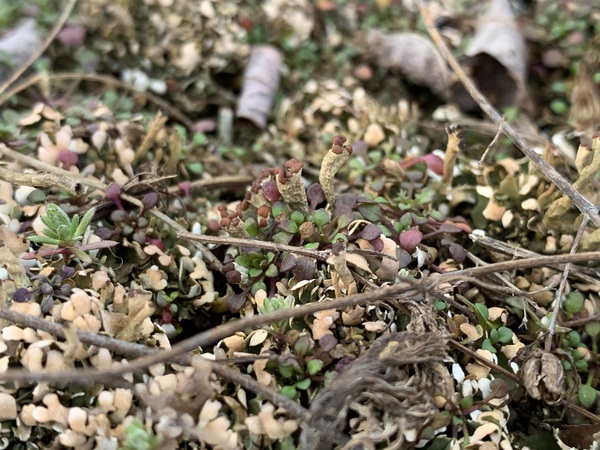
Gabriele Gheza - https://lichenidilombardia.home.blog
Italy, Lombardia, Varese, Vizzola Ticino, valle del Ticino, 162 m
17/03/2021
fertile specimens
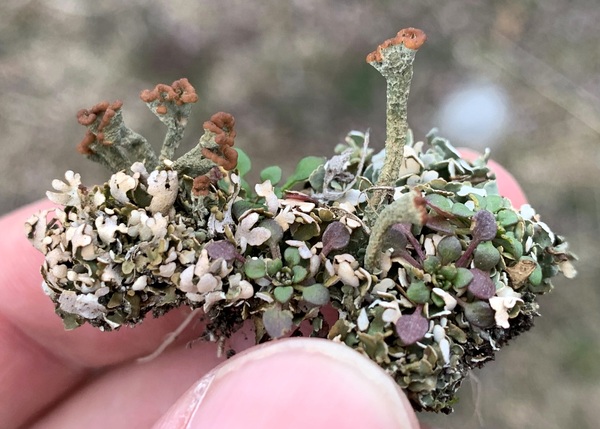
Gabriele Gheza - https://lichenidilombardia.home.blog
Italy, Lombardia, Varese, Vizzola Ticino, valle del Ticino, 162 m
17/03/2021
fertile specimens
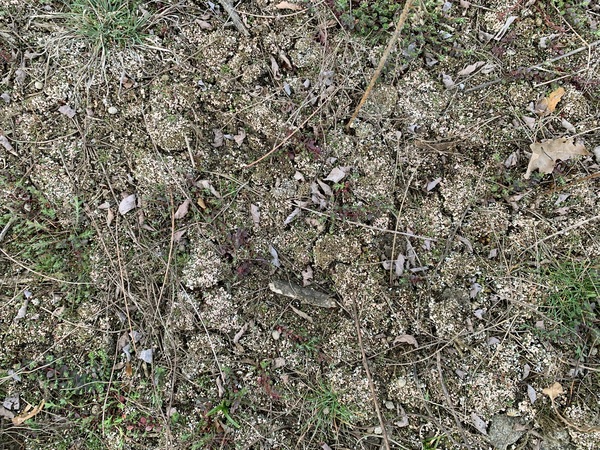
Gabriele Gheza - https://lichenidilombardia.home.blog
Italy, Lombardia, Varese, Vizzola Ticino, valle del Ticino, 162 m
17/03/2021
fertile specimens

Gabriele Gheza - https://lichenidilombardia.home.blog
Italy, Piemonte, Vercelli, Arborio, greto del Sesia, 150 m
02/2017
fertile specimens
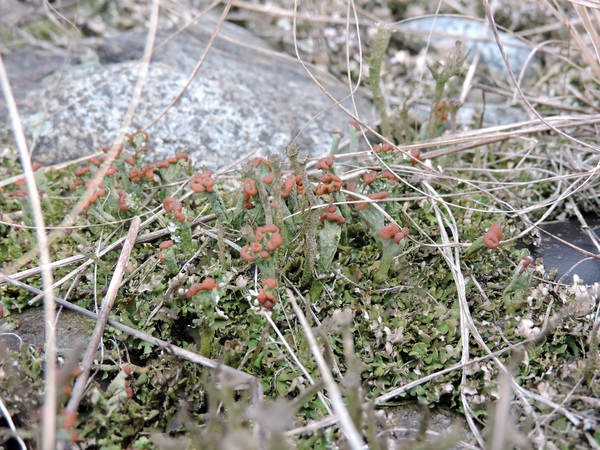
Gabriele Gheza - https://lichenidilombardia.home.blog
Italy, Piemonte, Vercelli, Arborio, greto del Sesia, 150 m
02/2017
fertile specimens
Growth form: Fruticose
Substrata: soil, terricolous mosses, and plant debris
Photobiont: green algae other than Trentepohlia
Reproductive strategy: mainly sexual
Commonnes-rarity: (info)
Alpine belt: absent
Subalpine belt: extremely rare
Oromediterranean belt: absent
Montane belt: rather rare
Submediterranean belt: very rare
Padanian area: extremely rare
Humid submediterranean belt: absent
Humid mediterranean belt: absent
Dry mediterranean belt: absent

Predictive model
| Herbarium samples |

Gabriele Gheza - https://lichenidilombardia.home.blog
Italy, Lombardia, Varese, Vizzola Ticino, valle del Ticino, 162 m
17/03/2021

Gabriele Gheza - https://lichenidilombardia.home.blog
Italy, Lombardia, Varese, Vizzola Ticino, valle del Ticino, 162 m
17/03/2021
fertile specimens

Gabriele Gheza - https://lichenidilombardia.home.blog
Italy, Lombardia, Varese, Vizzola Ticino, valle del Ticino, 162 m
17/03/2021
fertile specimens

Gabriele Gheza - https://lichenidilombardia.home.blog
Italy, Lombardia, Varese, Vizzola Ticino, valle del Ticino, 162 m
17/03/2021
fertile specimens

Gabriele Gheza - https://lichenidilombardia.home.blog
Italy, Lombardia, Varese, Vizzola Ticino, valle del Ticino, 162 m
17/03/2021
fertile specimens

Gabriele Gheza - https://lichenidilombardia.home.blog
Italy, Lombardia, Varese, Vizzola Ticino, valle del Ticino, 162 m
17/03/2021
fertile specimens

Gabriele Gheza - https://lichenidilombardia.home.blog
Italy, Lombardia, Varese, Vizzola Ticino, valle del Ticino, 162 m
17/03/2021
fertile specimens

Gabriele Gheza - https://lichenidilombardia.home.blog
Italy, Piemonte, Vercelli, Arborio, greto del Sesia, 150 m
02/2017
fertile specimens

 INDEX FUNGORUM
INDEX FUNGORUM
 GBIF
GBIF
 DOLICHENS
DOLICHENS
